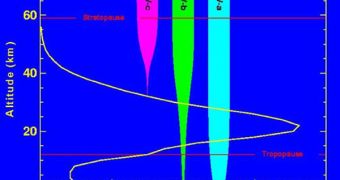According to a new research paper released by the European Space Agency (ESA), the ozone depletion in our atmosphere is leveling off, a direct consequence of the banning of chlorofluorocarbons (CFC) with the Montreal Protocol, signed in 1987. A fine example of how nations can come to work together when faced with a common threat, the agreement essentially ensured that the atmosphere would not lose its ability to stop harmful UV radiation from penetrating all the way to the Earth's surface. The new study, which combines a decade of observations, shows promising results.
If the ozone layer were to be depleted, we would essentially be fried down on the surface. Huge amounts of UV radiation, which are now held at bay by the protective layer, would reach the surface and bring about immediate effects, such as a huge raise in the incidence of skin cancer and related deaths. Simulations released by several research institutes over the past couple of years show how the planet would have looked like if CFC had not been banned, and present an image we must be happy to have avoided.
The ESA investigation combines data collected by the GOME instrument on ESA's ERS-2 satellite, the SCIAMACHY instrument on ESA's Envisat, and the GOME-2 instrument on the European Meteorological Satellite Organization's MetOp-A satellite. All these devices are able to perform vertically downward-looking measurements every month, and their readings were combined to create the first homogeneous, long-term ozone record. This allowed researchers to finally look at global trends spanning the entire atmosphere, and to assess the overall condition of the ozone layer.
“We found a global slightly positive trend of ozone increase of almost 1% per decade in the total ozone from the last 14 years: a result that was confirmed by comparisons with ground-based measurements,” project expert Diego G. Loyola R. says. For the new results, he worked together with fellow scientists from the German Aerospace Center (DLR).
“Our analysis shows that upper stratospheric ozone declines at northern and southern mid-latitudes at roughly 7% per decade during 1979, consistent with earlier studies based on data from satellites and ground networks. A clear statistically significant change of trend can be seen around 1997. The small increase observed thereafter, from 1997 to 2008, is however not yet statistically different from a zero trend. We hope to see a significant recovery of (upper stratospheric) ozone in the next years using longer, extended satellite time-series,” scientist Jo Urban, from the Chalmers University of Technology, in Sweden, adds.

 14 DAY TRIAL //
14 DAY TRIAL //